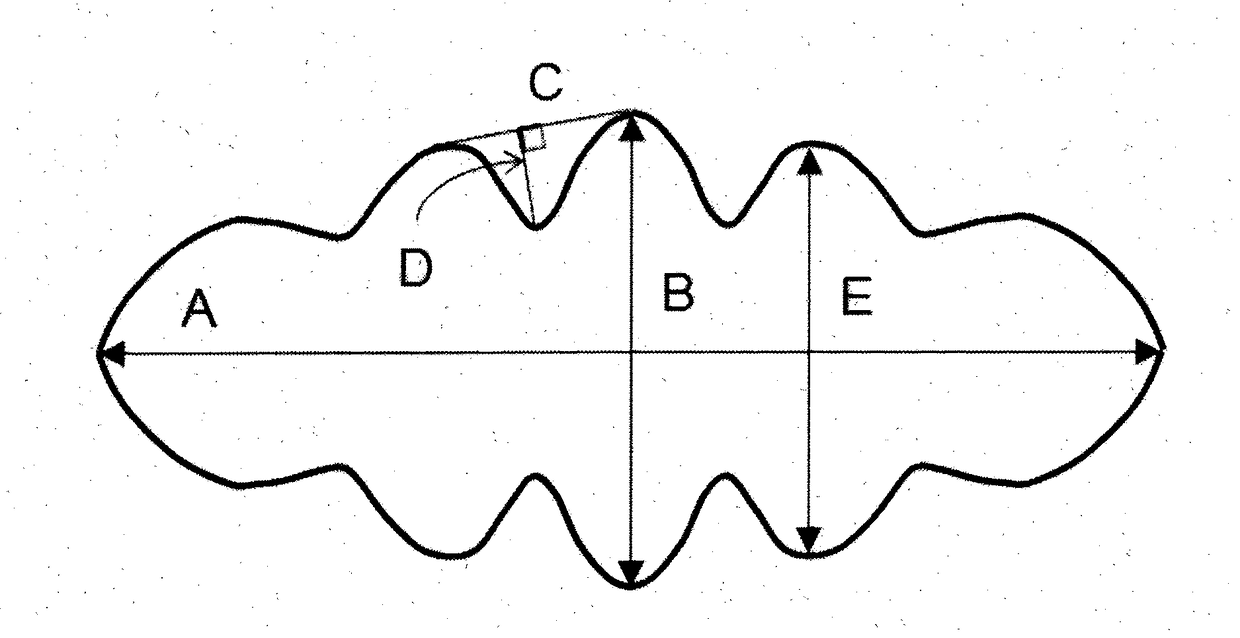Non-woven fabric for sanitary materials, and sanitary material product
a non-woven fabric and sanitary material technology, applied in the field of non-woven fabrics, can solve the problems of poor bristle falling properties, material proposals, and inability to provide non-woven fabrics with soft feeling to the skin, and achieve the effects of high water absorption, high diffusing capacity of liquids, and flexibility
- Summary
- Abstract
- Description
- Claims
- Application Information
AI Technical Summary
Benefits of technology
Problems solved by technology
Method used
Image
Examples
example 1
[0069]Using a spinneret containing special irregular-shaped holes for flattened multilobar cross section formation, polyethylene terephthalate with a molten polymer density of 1.18 g / cc was spun under the conditions of a spinning temperature of 290° C., a discharge rate of 400 g / min, a cooling air speed of 60 m / min, a cooling temperature of 25° C., and a take-up speed of 1,200 m / min to produce an undrawn yarn. The resulting undrawn yarn was stretched 3.3 times and crimped with a frequency of 13 crimps / 25 mm and a crimp rate of 14%, and a hydrophilizing agent (nonionic surface active agent containing a hydrophilic polyester component) is added to the fiber surface to 0.3 mass %, followed by drying at a temperature of 120° C. After the drying, the resulting yarn was cut to 51 mm to provide polyester fiber (with a single filament fineness of 1.7 dtex) with a flattened multilobar cross section that had a flatness of 2.1, a degree of irregularity of 2.0, a convex ratio of 0.6, and a cros...
example 2
[0071]Using a spinneret containing special irregular-shaped holes for flattened multilobar cross section formation, polyethylene terephthalate with a molten polymer density of 1.18 g / cc was spun under the conditions of a spinning temperature of 285° C., a discharge rate of 400 g / min, a cooling air speed of 80 m / min, a cooling temperature of 20° C., and a take-up speed of 1,200 m / min to produce an undrawn yarn. The resulting undrawn yarn is stretched 3.3 times and crimped with a frequency of 13 crimps / 25 mm and a crimp rate of 14%, and a hydrophilizing agent is added to the fiber surface to 0.3 mass %, followed by drying at a temperature of 120° C. After the drying, the resulting yarn was cut to 51 mm to provide polyester fiber (with a single filament fineness of 1.7 dtex) with a flattened multilobar cross section that had a flatness of 2.7, a degree of irregularity of 4.0, a convex ratio of 0.8, and a cross-sectional shape containing 8 convex portions.
[0072]The polyester fiber thus ...
example 3
[0073]Using a spinneret containing special irregular-shaped holes for flattened multilobar cross section formation, polyethylene terephthalate with a molten polymer density of 1.18 g / cc was spun under the conditions of a spinning temperature of 290° C., a discharge rate of 400 g / min, a cooling air speed of 60 m / min, a cooling temperature of 25° C., and a take-up speed of 1,200 m / min to produce an undrawn yarn. The resulting undrawn yarn was stretched 3.3 times and crimped with a frequency of 13 crimps / 25 mm and a crimp rate of 14%, and a hydrophilizing agent is added to the fiber surface to 0.3 mass %, followed by drying at a temperature of 120° C. After the drying, the resulting yarn was cut to 51 mm to provide polyester fiber (with a single filament fineness of 1.7 dtex) with a flattened multilobar cross section that had a flatness of 2.1, a degree of irregularity of 2.0, a convex ratio of 0.6, and a cross-sectional shape containing 8 convex portions.
[0074]A uniform mixture of 90 ...
PUM
| Property | Measurement | Unit |
|---|---|---|
| length | aaaaa | aaaaa |
| aperture angle | aaaaa | aaaaa |
| circumference | aaaaa | aaaaa |
Abstract
Description
Claims
Application Information
 Login to View More
Login to View More - R&D
- Intellectual Property
- Life Sciences
- Materials
- Tech Scout
- Unparalleled Data Quality
- Higher Quality Content
- 60% Fewer Hallucinations
Browse by: Latest US Patents, China's latest patents, Technical Efficacy Thesaurus, Application Domain, Technology Topic, Popular Technical Reports.
© 2025 PatSnap. All rights reserved.Legal|Privacy policy|Modern Slavery Act Transparency Statement|Sitemap|About US| Contact US: help@patsnap.com


